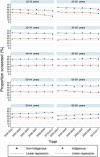The first comprehensive report on Indigenous Australian women's inequalities in cervical screening: A retrospective registry cohort study in Queensland, Australia (2000-2011)
- PMID: 27149550
- PMCID: PMC5074237
- DOI: 10.1002/cncr.29954
The first comprehensive report on Indigenous Australian women's inequalities in cervical screening: A retrospective registry cohort study in Queensland, Australia (2000-2011)
Abstract
Background: The Australian National Cervical Screening Program, introduced more than 20 years ago, does not record the Indigenous status of screening participants. This article reports the first population-based estimates of participation in cervical screening for Indigenous and non-Indigenous Australian women.
Methods: This was a retrospective, population-based study of 1,334,795 female Queensland residents, aged 20 to 69 years, who participated in cervical screening from 2000 to 2011; 26,829 were identified as Indigenous through linkage to hospitalization records. Participation rates were calculated as the number of women screened divided by the average estimated resident population, with adjustments made for hysterectomies, for each 2-, 3-, and 5-year screening period. Multivariate logistic regression was used to estimate odds ratios (ORs) and 95% confidence intervals (CIs), which were adjusted for age group, place of residence, and socioeconomic disadvantage.
Results: In 2010-2011, the 2-year participation rate was 55.7% (95% CI, 55.6%-55.9%) for non-Indigenous women and 33.5% (95% CI, 32.9%-34.1%) for Indigenous women; this represented a decrease from 2000-2001 (57.7% [95% CI, 57.6%-57.9%] and 35.3% [95% CI, 34.5%-36.1%], respectively). The difference between Indigenous and non-Indigenous women was greatest for those aged 45 to 49 years. The 3- and 5-year participation rates were higher within both groups, and the absolute differences between the 2 groups were larger. Significant interactions between the Indigenous status and the place of residence and socioeconomic disadvantage highlight that the Indigenous/non-Indigenous differential was evident in all places of residence except for very remote areas (OR, 0.99; 95% CI, 0.95-1.02) and was greatest in the most affluent areas (OR, 0.26; 95% CI, 0.24-0.27).
Conclusions: Indigenous Australian women participate less than non-Indigenous women, and this gap has not closed. These results provide important benchmarks for the new Australian cervical screening program commencing in 2017, which will provide opportunities to reduce inequities for Indigenous women and address longstanding data deficiencies in the collection of the Indigenous status. Cancer 2016;122:1560-9. © 2016 The Authors. Cancer published by Wiley Periodicals, Inc. on behalf of American Cancer Society.
Keywords: Indigenous Australian; Papanicolaou (Pap) test; cancer; cervical screening; early detection; health care disparities.
© 2016 The Authors. Cancer published by Wiley Periodicals, Inc. on behalf of American Cancer Society.
Figures



References
-
- Australian Institute of Health and Welfare . Cervical Screening in Australia 2012–2013. Canberra, Australia: Australian Institute of Health and Welfare; 2015.
-
- Ferlay J, Soerjomataram I, Dikshit R, et al. Cancer incidence and mortality worldwide: sources, methods and major patterns in GLOBOCAN 2012. Int J Cancer. 2015;136:E359–E386. - PubMed
-
- Diaz A, Moore SP, Martin JH, Green AC, Garvey G, Valery PC. Factors associated with cancer‐specific and overall survival among Indigenous and non‐Indigenous gynecologic cancer patients in Queensland, Australia: a matched cohort study. Int J Gynecol Cancer. 2015;25:542–547. - PubMed
-
- Binns PL, Condon JR. Participation in cervical screening by Indigenous women in the Northern Territory: a longitudinal study. Med J Aust. 2006;185:490–494. - PubMed
Publication types
MeSH terms
LinkOut - more resources
Full Text Sources
Other Literature Sources
Medical
Research Materials
Miscellaneous

